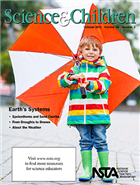Documenting weather changes
By Peggy Ashbrook
Posted on 2015-10-01
 As the wind stirs up and we get a full day of long-awaited rain, children arrive at school in rain boots and coats, and a few in soaking wet sandals. Hurricane Joaquin will bring more rain and wind this weekend as it moves north in the Atlantic, hopefully off the coast not inland.
As the wind stirs up and we get a full day of long-awaited rain, children arrive at school in rain boots and coats, and a few in soaking wet sandals. Hurricane Joaquin will bring more rain and wind this weekend as it moves north in the Atlantic, hopefully off the coast not inland.
Taking young children outside to observe the short-term conditions of the atmosphere—weather—is a foundation for later learning about the average daily weather for an extended period of time at that location—climate—as defined by the National Ocean Service of the National Oceanic and Atmospheric Administration.
Visit the National Weather Service’s JetStream: Online School for Weather page and scroll down to see the Köppen climates map. The continental USA has ranges in normal temperatures and amounts of precipitation, so no single lesson plan on weather observations  will be a good fit for all. Teaching about your local weather will provide the most opportunities for direct observation that can deepen children’s understanding about weather.
will be a good fit for all. Teaching about your local weather will provide the most opportunities for direct observation that can deepen children’s understanding about weather.
In the October 2015 issue of Science and Children I wrote about children counting and graphing the number of short sleeve shirts, sweaters and jackets that classmates wore to school each day. The clothing is a symbol for the weather, and observing changing trends in outerwear is a focused way to track changes in the immense phenomena that is weather.
Disclaimer: The views expressed in this blog post are those of the author(s) and do not necessarily reflect the official position of the National Science Teaching Association (NSTA).

